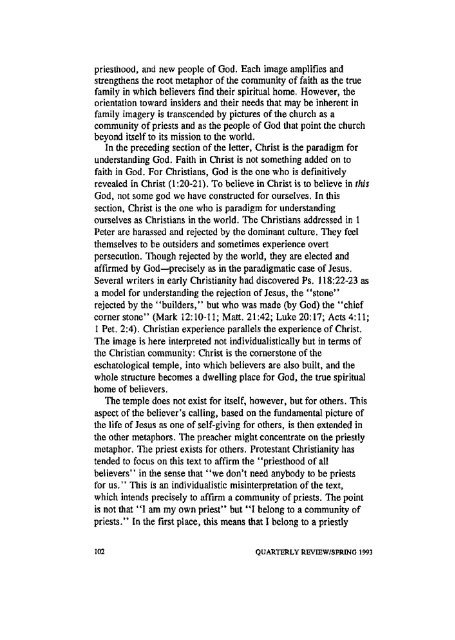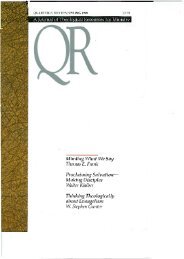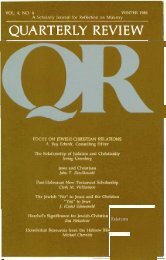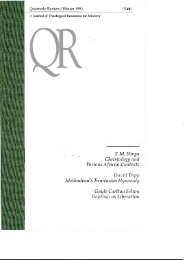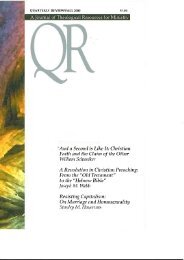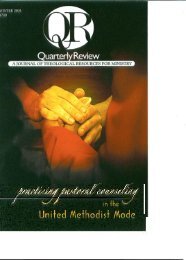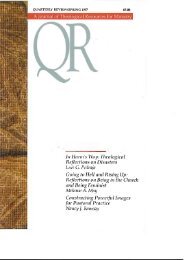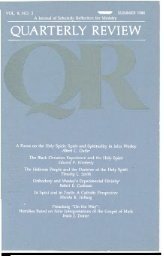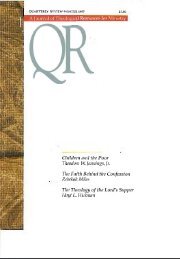TJieodore W. Jennings, Jr. The Meaning of ... - Quarterly Review
TJieodore W. Jennings, Jr. The Meaning of ... - Quarterly Review
TJieodore W. Jennings, Jr. The Meaning of ... - Quarterly Review
You also want an ePaper? Increase the reach of your titles
YUMPU automatically turns print PDFs into web optimized ePapers that Google loves.
priesthood, and new people <strong>of</strong> God. Each image amplifies and<br />
strengthens the root metaphor <strong>of</strong> the community <strong>of</strong> faith as the true<br />
family in which believers find their spiritual home. However, the<br />
orientation toward insiders and their needs that may be inherent in<br />
family imagery is transcended by pictures <strong>of</strong> the church as a<br />
community <strong>of</strong> priests and as the people <strong>of</strong> God that point the church<br />
beyond itself to its mission to the world.<br />
In the preceding section <strong>of</strong> the letter, Christ is the paradigm for<br />
understanding God. Faith in Christ is not something added on to<br />
faith in God. For Christians, God is the one who is definitively<br />
revealed in Christ (1:20-21). To believe in Christ is to believe in this<br />
God, not some god we have constructed for ourselves. In this<br />
section, Christ is the one who is paradigm for understanding<br />
ourselves as Christians in the world. <strong>The</strong> Christians addressed in 1<br />
Peter are harassed and rejected by the dominant culture. <strong>The</strong>y feel<br />
themselves to be outsiders and sometimes experience overt<br />
persecution. Though rejected by the world, they are elected and<br />
affirmed by God—precisely as in the paradigmatic case <strong>of</strong> Jesus.<br />
Several writers in early Christianity had discovered Ps. 118:22-23 as<br />
a model for understanding the rejection <strong>of</strong> Jesus, the "stone"<br />
rejected by the "builders," but who was made (by God) the "chief<br />
corner stone" (Mark 12:10-11; Matt. 21:42; Luke 20:17; Acts 4:11;<br />
1 Pet. 2:4). Christian experience parallels the experience <strong>of</strong> Christ.<br />
<strong>The</strong> image is here interpreted not individualistically but in terms <strong>of</strong><br />
the Christian community: Christ is the cornerstone <strong>of</strong> the<br />
eschatological temple, into which believers are also built, and the<br />
whole structure becomes a dwelling place for God, the true spiritual<br />
home <strong>of</strong> believers.<br />
<strong>The</strong> temple does not exist for itself, however, but for others. This<br />
aspect <strong>of</strong> the believer's calling, based on the fundamental picture <strong>of</strong><br />
the life <strong>of</strong> Jesus as one <strong>of</strong> self-giving for others, is then extended in<br />
the other metaphors. <strong>The</strong> preacher might concentrate on the priestly<br />
metaphor. <strong>The</strong> priest exists for others. Protestant Christianity has<br />
tended to focus on this text to affirm the "priesthood <strong>of</strong> all<br />
believers" in the sense that "we don't need anybody to be priests<br />
for us." This is an individualistic misinterpretation <strong>of</strong> the text,<br />
which intends precisely to affirm a community <strong>of</strong> priests. <strong>The</strong> point<br />
is not that "I am my own priest" but "I belong to a community <strong>of</strong><br />
priests." In the first place, this means that I belong to a priestly<br />
102 QUARTERLY REVIEW/SPRING 1993


